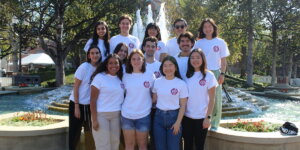
ISI researchers at QLIlab are using quantum mechanics to make telecomms more secure
As life gets more digital, the need for highly secure communications is becoming more important. Telecommunications, which is what keeps us all connected in the modern world, is much more vulnerable to cyber attacks compared to other industries like banking and retail.
So how can we make communications more secure?
The Lab for Quantum Limited Information (QLIlab) is answering this question through developing technology that uses quantum physics to boost telecommunications security. The project is led by PI Arunkumar Jagannathan, physicist at USC’s Information Sciences Institute (ISI) and co-PI Jonathan Habif, Research Lead at ISI and Research Assistant Professor in the Department of Electrical and Computer Engineering at USC.
Funded by the US Department of Defense (DoD) as part of its Defense University Research Instrumentation Program (DURIP), the project will help expand the capabilities of QLIlab into new areas in quantum information sciences.
“We are building a flexible quantum-limited sensing testbed that’s geared towards performing cutting edge quantum information experiments,” Jagannathan explained. “The newly developed capabilities, as result of this DoD award, will also help our lab to train the next generation quantum workforce.”
The QLIlab team will conduct their experiments using entangled photons, which is when two linked particles share properties with each other, with the measurement of one particle’s properties mysteriously influencing the other no matter the distance between them.
From the Astronomical to the Atomic
A foundational area of science, physics is the study of matter, energy, motion and force. One of the most exciting branches of physics is quantum mechanics, which can be as puzzling as it is fascinating.
As Jagannathan noted, classical physics can explain macroscopic phenomenon that happens in the world we experience. “It can explain, for example, the behavior of a tennis ball, such as its position in real world (e.g., 42nd street in Boston, MA)” he said.
However, the limitations of classical physics are made apparent when we get down to the nitty gritty, as it can’t explain the behavior of objects at the microscopic level.
“If the same tennis ball is shrunk to a size of an atom, the tennis ball can no longer be treated as a particle, since it’ll exhibit wavelike properties, and the exact position of the tennis ball becomes uncertain,” he continued. “This is where we need quantum physics, where the position of the tennis ball can now be explained in terms of probabilities.”
Quantum physics explains to us how the universe works on an atomic and subatomic level. While it can seem abstract, its applications are actually very familiar to us.
For example, smartphones and laptops exist only because of strides made in quantum physics research — we now know how to use the laws of quantum mechanics to build better processors, which are the lifeblood of smartphones.
“Technological breakthroughs like this wouldn’t be possible without quantum physics,” Jagannathan emphasized.
Quantum’s the Limit
Quantum physics tells us that light is made up of tiny, wavelike particles, so it’s important to have tools, like optical receivers, that can detect photons, the fundamental particles of light. These tools work by accurately determining how many photons hit the receiver at a certain time. However, traditional optical receivers are limited to classical physics and can’t extract all the information available to them when they’re hit with photons.
“Classical optical receivers are severely limited in their performance,” said Habif. “We need optical receivers that exploit the full power of quantum mechanics to improve the measurement precision and achieve the fundamental limit that’s set by nature – the quantum limit.”
The quantum limit is the ultimate limit allowed by nature. This limit can be achieved if an optical receiver is built using the laws of quantum physics.
Improving optical receivers can be beneficial in many industries, including telecommunications. The next-generation optical receivers the QLIlab team is developing can be used to achieve quantum secure communication. With quantum communication, data is secured by being transmitted as quantum bits, or qubits, the smallest unit of data in a quantum computer — this makes it much more difficult for hackers to break into and decode the transmitted data.
“Currently, communication of secure information, such as online credit card transactions, are done using classical physics,” Jagannathan said. “Although they’re secure, they can be hacked with powerful computers or with the advent of quantum computers. Our optical receivers would aid in achieving quantum secure communication that exploits quantum mechanics and will provide superior security compared to the existing standard.”
By utilizing the mysterious and exciting concepts of quantum mechanics, QLIlab researchers are taking telecommunications to a new level of security with this project and look to continue developing cutting-edge technology to advance the field. Quantum physics is like the rebel of the sciences, defying traditional scientific laws, constantly pushing boundaries, and making the impossible possible — and ultimately, that’s what QLIlab’s mission is all about.
“Understanding quantum mechanics is very important because it helps us understand the world at the fundamental level,” said Jagannathan. “Although we don’t directly observe things at the atomic level in our lives every day, the physics of the microscopic world plays a critical role in our lives now more than ever before.”
Published on April 16th, 2021
Last updated on April 24th, 2025











